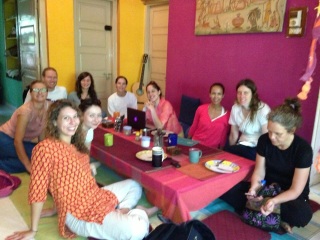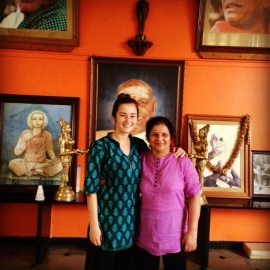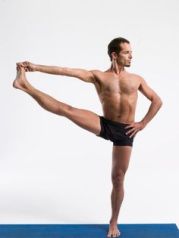I have been living in a city called Mysore, located in India, for almost two months now. Mysore is the third largest city in the state of Karnataka and is home to approximately 900,000. However, where I live it is hard to tell that this city inhabits so many people. My home and yoga shala are both located in the cozy district of Gokulam, just Northwest of Mysore’s city center.
Gokulam is a very peaceful place and while spending time here it is easy to forget that this is India. Many westerners flock here in search of traditional or “real” Ashtanga yoga and to experience the yogic lifestyle. I’m currently studying with Saraswathi Jois, she is the daughter of Pattabhi Jois (the developer of Ashtanga Yoga). Pattabhi Jois also created the Sri K Pattabhi Jois Ashtanga Yoga Institute, where I am currently studying. If you are interested in learning more about the definition of Ashtanga as a tradition, please visit the link above.
Six days a week I wake up at around four in the morning and prepare for yoga practice. There is something magical about practicing at Saraswathi’s shala during the early hours of the day. Focus and precision are so readily available, and it also serves as a personal check-in before the day begins, giving each practitioner the opportunity to ask themselves questions such as,
“How am I doing today? Is my mind clear and steady, or is it crowded with distracting thoughts and feelings?”
After assessing how the body and mind are feeling that morning it is then time to start whatever sequence of asanas (postures) the guru or teacher has designated to you at this time.
At KPJAYI we practice “Mysore” style Monday through Friday, and on Saturday, Saraswathi conducts a “lead” class where she vocally guides us through the first or “Primary” series of postures. “Mysore” style Ashtanga indicates a self-lead practice, this is one major characteristic that differentiates Ashtanga from other traditions of yoga.
What self-lead practice means is that everyday the same sequence of postures is practiced without instruction and at your own pace. Adjustments and guidance are given individually to students as needed, and new postures will only be practiced when they are appointed at the teachers discretion. Some may view this as repetitive or boring, but the purpose is to free the mind of having to think about what comes next. This creates a greater awareness of the subtle body, and also allows new and different sensations to become more noticeable. Most importantly, practicing the same sequence each time allows the practitioner to gain a greater awareness of the transformation occurring within the self. When the body instinctively knows where to go next, the mind is left to witness thought patterns and explore what is truly causing feelings of discomfort.
After practice we leave the shala to enjoy a fresh coconut water (or four) before starting the rest of our day. Everyone is on different schedules here, some loaded with obligations, while others leisurely enjoy their “holiday” before returning back to their homes or continue traveling.
Either way, the physical practice enables the mind to think more clearly in any situation, particularly those that make us uncomfortable. By witnessing the thoughts rather than subjecting ourselves to them, we become more capable of having sound judgement and not allowing the mind to be controlled by irrational thinking and behavior. If it is possible to maintain a concentrated and steady mind while balancing on one leg in Utthita Hasta Padangusthasana (Extended hand-to-big-toe pose, pictured, right), then hopefully this sense of balance and ease can be carried into daily life, even in difficult situations.
This is only a brief insight on my time spent in India so far and I plan on sharing a post that is more culturally related soon. There is so much more to this region of the world that makes it fascinating, but Ashtanga is what brought me to Incredible India this time, and will surely be a reason I continue to return.


